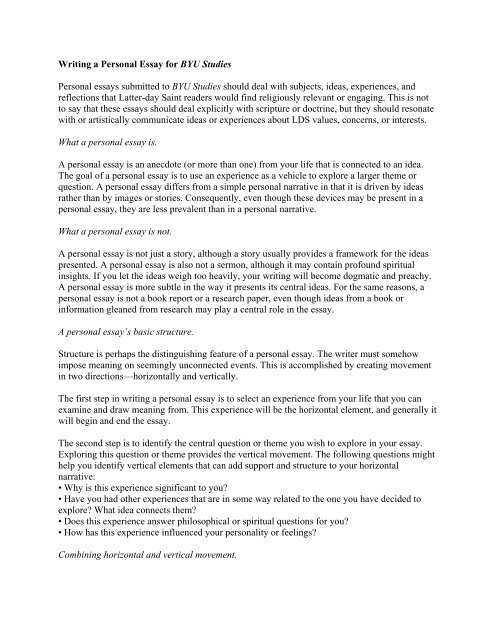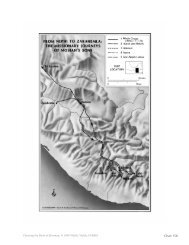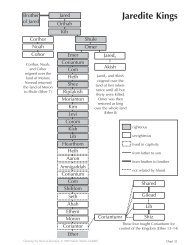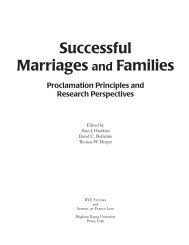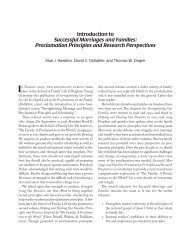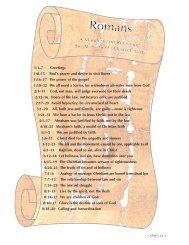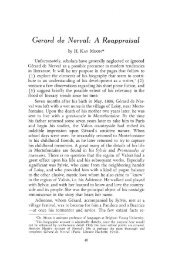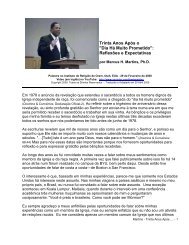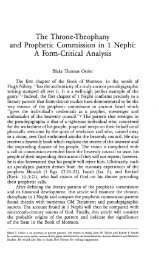Writing a Personal Essay for BYU Studies
Writing a Personal Essay for BYU Studies
Writing a Personal Essay for BYU Studies
Create successful ePaper yourself
Turn your PDF publications into a flip-book with our unique Google optimized e-Paper software.
<strong>Writing</strong> a <strong>Personal</strong> <strong>Essay</strong> <strong>for</strong> <strong>BYU</strong> <strong>Studies</strong><br />
<strong>Personal</strong> essays submitted to <strong>BYU</strong> <strong>Studies</strong> should deal with subjects, ideas, experiences, and<br />
reflections that Latter-day Saint readers would find religiously relevant or engaging. This is not<br />
to say that these essays should deal explicitly with scripture or doctrine, but they should resonate<br />
with or artistically communicate ideas or experiences about LDS values, concerns, or interests.<br />
What a personal essay is.<br />
A personal essay is an anecdote (or more than one) from your life that is connected to an idea.<br />
The goal of a personal essay is to use an experience as a vehicle to explore a larger theme or<br />
question. A personal essay differs from a simple personal narrative in that it is driven by ideas<br />
rather than by images or stories. Consequently, even though these devices may be present in a<br />
personal essay, they are less prevalent than in a personal narrative.<br />
What a personal essay is not.<br />
A personal essay is not just a story, although a story usually provides a framework <strong>for</strong> the ideas<br />
presented. A personal essay is also not a sermon, although it may contain profound spiritual<br />
insights. If you let the ideas weigh too heavily, your writing will become dogmatic and preachy.<br />
A personal essay is more subtle in the way it presents its central ideas. For the same reasons, a<br />
personal essay is not a book report or a research paper, even though ideas from a book or<br />
in<strong>for</strong>mation gleaned from research may play a central role in the essay.<br />
A personal essay’s basic structure.<br />
Structure is perhaps the distinguishing feature of a personal essay. The writer must somehow<br />
impose meaning on seemingly unconnected events. This is accomplished by creating movement<br />
in two directions—horizontally and vertically.<br />
The first step in writing a personal essay is to select an experience from your life that you can<br />
examine and draw meaning from. This experience will be the horizontal element, and generally it<br />
will begin and end the essay.<br />
The second step is to identify the central question or theme you wish to explore in your essay.<br />
Exploring this question or theme provides the vertical movement. The following questions might<br />
help you identify vertical elements that can add support and structure to your horizontal<br />
narrative:<br />
• Why is this experience significant to you?<br />
• Have you had other experiences that are in some way related to the one you have decided to<br />
explore? What idea connects them?<br />
• Does this experience answer philosophical or spiritual questions <strong>for</strong> you?<br />
• How has this experience influenced your personality or feelings?<br />
Combining horizontal and vertical movement.
The personal essay has been likened to a bridge. A well-designed bridge reaches from point A to<br />
point B using supports that rise from the level of the road. In a well-designed personal essay, the<br />
horizontal story also moves from point A to point B and is supported by vertical pillars, or ideas.<br />
To achieve a rhythm and harmony in your essay as it moves horizontally, find logical places in<br />
the narrative to attach these vertical pillars. Not all essays are alike, of course. <strong>Essay</strong>s may differ,<br />
<strong>for</strong> example, in both the length of their horizontal movement and the frequency and height of<br />
their vertical supports. Some are largely narrative with subtle vertical movement. Others may<br />
include a very brief narrative framework that introduces a long and elaborate treatment of the<br />
central idea.<br />
Beginning and ending the essay.<br />
As you consider the experience that will provide horizontal movement <strong>for</strong> your essay, ask<br />
yourself how you can relate the experience so that it creates both a beginning and an ending. You<br />
might tell half of the story at the beginning, then tell “the rest of the story” at the end. Perhaps<br />
you can relate the entire story at the beginning of your essay, then echo or mirror certain<br />
elements of the story at the end. Some writers choose a more subtle approach and select one<br />
important word or phrase from the opening that they repeat or refer to at the end. Regardless of<br />
how you choose to connect the beginning and ending of your essay, it is important to avoid an<br />
ambiguous, preachy, or clichéd ending. Use concrete language tied to the experience.<br />
Show rather than tell.<br />
<strong>Personal</strong> essay writers can learn from good fiction writers. They don’t just tell about what<br />
happened. They show. This is important <strong>for</strong> the narrative elements of a personal essay. Let’s look<br />
at an example to illustrate the difference.<br />
Show: Once my brother Karl and I were at the dentist waiting <strong>for</strong> my mom in the waiting room.<br />
A couple of older ladies walked in and settled themselves in the two chairs next to Karl. “How<br />
are you, young man?” said one. (People like Karl. He has an honest face.) Karl murmured a reply<br />
and the two old ladies started to converse discreetly. A look of intense pain came over Karl’s<br />
face as he looked over at me. “Marilyn! I have a problem!” he hissed.<br />
“What?” I hissed back.<br />
“I can’t really say!” he whispered.<br />
“Then tell me later,” I said, laughing.<br />
“It needs to be solved be<strong>for</strong>e we leave!” breathed Karl urgently.<br />
“Then what is it?” I said.<br />
Karl leaned closer. “That lady is . . . sitting . . . on . . . my . . . toothbrush!” he howled<br />
silently.<br />
(From Marilyn N. Nielson, “Reality through Reflection,” <strong>BYU</strong> <strong>Studies</strong> 44, no. 1 [2005]: 155.)<br />
Tell: Once my brother Karl and I were at the dentist waiting <strong>for</strong> my mom in the waiting room. A<br />
couple of older ladies walked in and settled themselves in the two chairs next to Karl. One asked<br />
how he was. He murmured a reply, but when the two old ladies started to converse discreetly, a<br />
look of intense pain came over Karl’s face as he looked over at me. One of them, he whispered,<br />
was sitting on his toothbrush.
Inexperienced writers tend to get so caught up in their own feelings that they <strong>for</strong>get the reader.<br />
The goal is not to in<strong>for</strong>m the reader about how you feel but to make the reader feel those<br />
emotions. Show, don’t just tell.<br />
Use conflict rather than crisis.<br />
Understanding the difference between crisis and conflict can spell the difference between an<br />
ordinary essay and an outstanding one. A crisis is an event, usually some sort of emergency.<br />
Generally, if you focus on a crisis, your essay will aim at presenting a resolution. A conflict, on<br />
the other hand, is a clash of wills or a difficult moral choice. Presenting the reader with a conflict<br />
will encourage introspection, an exploration of values, or an examination of choices.<br />
Consequently, it engages the reader more than a crisis does.<br />
Focus.<br />
One temptation that can dilute the <strong>for</strong>ce of your essay is to try to do too much. If you have too<br />
many questions or ideas to explore, the reader may find it difficult to discern your true message.<br />
Focus on a single theme, even if you have to toss aside a favorite experience or some dazzling<br />
insights that may be peripheral to your central idea. Don’t get distracted. Focus, focus, focus.<br />
Give the reader a gift.<br />
A personal essay is your gift to the reader. When you give a gift, you think about what the<br />
receiver needs, not what you need. A writer who thinks of self first is like the husband who gives<br />
his wife a skill saw because he thinks she’ll enjoy all the things he can make with it. Focus on<br />
the reader. Pull something truly significant from your life, package it in an appealing manner,<br />
and give it freely. In writing, as in business, your primary aim should be customer satisfaction.


